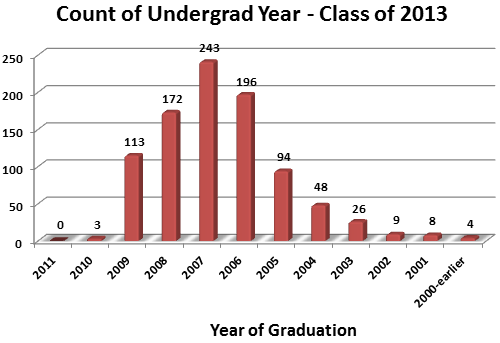HBS CLASS OF 2013 PROFILE
Jul, 17, 2011
Categories: Admissions Consulting | HBS | MBA | MBA留学
I wanted to briefly discuss the HBS Class of 2013’s profile and consider what it means for future applicants. For my analysis of the essays and recommendations for the Class of 2015, please see:
AGE
On June 21st, Harvard Business School’s Admissions Director posted the following “Class of 2013 Graduation Years” chart:
As you can see, the 4 members of the Class of 2013 who received their undergraduate degrees in 2000 (Assuming graduation at age 22, approximately age 33 or older) or earlier represented .4% of the Class of 2013’s 918 students. The total percentage of those 30 and over could be not much more than (Graduated 2003 or earlier) approximately 5% of the Class of 2013. You can look at this in a few ways:
1. The chance for admission to HBS when you are 30 and over at the time of matriculation is pretty low.
2. There is a chance for admission for those over 30 and the percentage is so small because the entering class at HBS is huge. It is important to consider that while HBS only takes 12% of those that apply, it is a giant class.
3. Applying to HBS when you are 30 or older is very risky and hence should be combined with application to other programs except for those with a very high risk tolerance.
According to the Class of 2013 statistics, the average age for the class will be 27. Compared to the Class of 2012 (11% acceptance rate), it was 1% easier to get into the Class of 2013, but actually the typical rate in recent years has been 12%, so I would not look at this as any sort of meaningful trend.
Two other meaningful trends that have been widely reported about the Class of 2013 are worth keeping in mind.
1. Percentage of Finance professionals down, manufacturing and technology professionals up
The Wall Street Journal did a good job on reporting on this:
Harvard Business School’s incoming class will have a substantially smaller percentage of finance professionals than in previous years. Instead, a higher number of students will have manufacturing and technology backgrounds.
Harvard administrators say the change reflects a greater quantity of strong applicants from nonfinance industries. The number of applicants from the finance world decreased as recession woes eased, as well.
Students with manufacturing backgrounds make up 14% of the class of 2013, up from 9% the previous year. Technology rose three percentage points to 9%.
Though the school continually seeks to bring in a diverse mix of students, “We don’t run with quotas or targets,” says Deirdre Leopold, managing director of M.B.A. admissions and financial aid. “We drive towards what they can contribute to the overall learning.
I am not surprised to see schools like HBS decide to better diversify their classes. It would seem to be schools interests to make sure that they don’t let in too many finance people, especially as the American job market in this area is by means looking attractive. Assuming these trends continue, it will certainly impact future candidates. For those who had erroneously thought that HBS was not a school for engineers, they will hopefully take a second look. For those coming from the finance industry, all I can say is leverage your risk.
2. A very positive indicator is the increase in the percentage of woman who are part of the Class of 2013. With 39% female, this will be the highest percentage ever. Hopefully this percentage will continue to grow.
Finally, whatever categories you might fall into, just operate on the assumption that you are more than your statistical breakdown. The admissions process at HBS goes beyond such facts to the individual. If you think you are right for HBS, the only way to find out is to apply!

